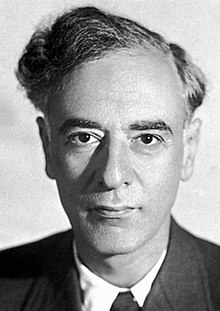Lev Landau
Lev Davidovich Landau (Russian: Лев Дави́дович Ланда́у; 22 January 1908 – 1 April 1968) was a Soviet physicist who made fundamental contributions to many areas of theoretical physics.[1][2][3] He was also involved in the design of the Soviet atomic bomb.
His accomplishments include the independent co-discovery of the density matrix method[4][5] in quantum mechanics (alongside John von Neumann), the quantum mechanical theory of diamagnetism, the theory of superfluidity, the theory of second-order phase transitions, invention of order parameter technique,[6] the Ginzburg–Landau theory of superconductivity, the theory of Fermi liquids, the explanation of Landau damping in plasma physics, the Landau pole in quantum electrodynamics, the two-component theory of neutrinos, and Landau's equations for S-matrix singularities.[7] He received the 1962 Nobel Prize in Physics for his development of a mathematical theory of superfluidity that accounts for the properties of liquid helium II at a temperature below 2.17 K (−270.98 °C).[8]
Life
Early years
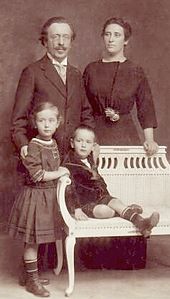
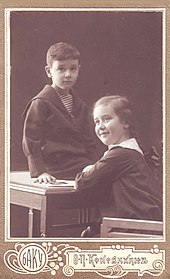
Landau was born on 22 January 1908 to Jewish parents[8][9][10][11] in Baku, the Russian Empire, in what is now Azerbaijan. Landau's father, David Lvovich Landau, was an engineer with the local oil industry, and his mother, Lyubov Veniaminovna Garkavi-Landau, was a doctor. Both came to Baku from Mogilev and both graduated the Mogilev gymnasium.[12][13] He learned differential calculus at age 12 and integral calculus at age 13. Landau graduated in 1920 at age 13 from gymnasium. His parents considered him too young to attend university, so for a year he attended the Baku Economical Technical School. In 1922, at age 14, he matriculated at the Baku State University, studying in two departments simultaneously: the Departments of Physics and Mathematics, and the Department of Chemistry. Subsequently, he ceased studying chemistry, but remained interested in the field throughout his life.
Leningrad and Europe
In 1924, he moved to the main centre of Soviet physics at the time: the Physics Department of Leningrad State University, where he dedicated himself to the study of theoretical physics, graduating in 1927. Landau subsequently enrolled for post-graduate studies at the Leningrad Physico-Technical Institute where he eventually received a doctorate in Physical and Mathematical Sciences in 1934.[14] Landau got his first chance to travel abroad during the period 1929–1931, on a Soviet government—People's Commissariat for Education—travelling fellowship supplemented by a Rockefeller Foundation fellowship. By that time he was fluent in German and French and could communicate in English.[15] He later improved his English and learned Danish.[16]
After brief stays in Göttingen and Leipzig, he went to Copenhagen on 8 April 1930 to work at the Niels Bohr's Institute for Theoretical Physics. He stayed there until 3 May of the same year. After the visit, Landau always considered himself a pupil of Niels Bohr and Landau's approach to physics was greatly influenced by Bohr. After his stay in Copenhagen, he visited Cambridge (mid-1930), where he worked with Paul Dirac,[17] Copenhagen (September to November 1930),[18] and Zürich (December 1930 to January 1931), where he worked with Wolfgang Pauli.[17] From Zürich Landau went back to Copenhagen for the third time[19] and stayed there from 25 February until 19 March 1931 before returning to Leningrad the same year.[20]
National Scientific Center Kharkiv Institute of Physics and Technology, Kharkiv
Between 1932 and 1937, Landau headed the Department of Theoretical Physics at the National Scientific Center Kharkiv Institute of Physics and Technology, and he lectured at the University of Kharkiv and the Kharkiv Polytechnic Institute. Apart from his theoretical accomplishments, Landau was the principal founder of a great tradition of theoretical physics in Kharkiv, Ukraine, sometimes referred to as the "Landau school". In Kharkiv, he and his friend and former student, Evgeny Lifshitz, began writing the Course of Theoretical Physics, ten volumes that together span the whole of the subject and are still widely used as graduate-level physics texts. During the Great Purge, Landau was investigated within the UPTI Affair in Kharkiv, but he managed to leave for Moscow to take up a new post.[3]
Landau developed a famous comprehensive exam called the "Theoretical Minimum" which students were expected to pass before admission to the school. The exam covered all aspects of theoretical physics, and between 1934 and 1961 only 43 candidates passed, but those who did later became quite notable theoretical physicists.[21][22]
In 1932, Landau computed the Chandrasekhar limit;[23] however, he did not apply it to white dwarf stars.[24]
Institute for Physical Problems, Moscow
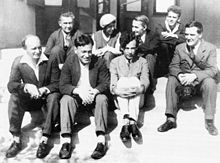
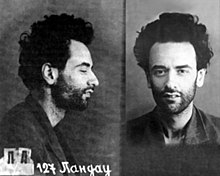
From 1937 until 1962, Landau was the head of the Theoretical Division at the Institute for Physical Problems.[25]
On 27 April 1938, Landau was arrested for a leaflet which compared Stalinism to German Nazism and Italian Fascism.[3][26] He was held in the NKVD's Lubyanka prison until his release, on 29 April 1939, after Pyotr Kapitsa (an experimental low-temperature physicist and the founder and head of the institute) and Bohr wrote letters to Joseph Stalin.[27][28] Kapitsa personally vouched for Landau's behaviour and threatened to quit the institute if Landau was not released.[29] After his release, Landau discovered how to explain Kapitsa's superfluidity using sound waves, or phonons, and a new excitation called a roton.[3]
Landau led a team of mathematicians supporting Soviet atomic and hydrogen bomb development. He calculated the dynamics of the first Soviet thermonuclear bomb, including predicting the yield. For this work Landau received the Stalin Prize in 1949 and 1953, and was awarded the title "Hero of Socialist Labour" in 1954.[3]
Landau's students included Lev Pitaevskii, Alexei Abrikosov, Aleksandr Akhiezer, Igor Dzyaloshinskii, Evgeny Lifshitz, Lev Gor'kov, Isaak Khalatnikov, Roald Sagdeev and Isaak Pomeranchuk.
Scientific achievements
Landau's accomplishments include the independent co-discovery of the density matrix method in quantum mechanics (alongside John von Neumann), the quantum mechanical theory of diamagnetism, the theory of superfluidity, the theory of second-order phase transitions, the Ginzburg–Landau theory of superconductivity, the theory of Fermi liquids, the explanation of Landau damping in plasma physics, the Landau pole in quantum electrodynamics, the two-component theory of neutrinos, the explanation of flame instability (the Darrieus-Landau instability), and Landau's equations for S matrix singularities.
Landau received the 1962 Nobel Prize in Physics for his development of a mathematical theory of superfluidity that accounts for the properties of liquid helium II at a temperature below 2.17 K (−270.98 °C)."[30]
Personal life and views
In 1937, Landau married Kora T. Drobanzeva from Kharkiv.[31] Their son Igor (1946–2011) became a theoretical physicist. Lev Landau believed in "free love" rather than monogamy and encouraged his wife and his students to practise "free love". However, his wife was not enthusiastic.[3]
Landau was an atheist.[32][33][34] In 1957, a lengthy report to the CPSU Central Committee by the KGB recorded Landau's views on the 1956 Hungarian Uprising, Vladimir Lenin and what he termed "red fascism".[35] Hendrik Casimir recalls him as a passionate communist, emboldened by his revolutionary ideology. Landau's drive in establishing Soviet science was in part due to his devotion to socialism. In 1935 he published a piece entitled “Bourgeoisie and Contemporary Physics” in the Soviet newspaper Izvestia in which he criticized religious superstition and the dominance of capital, which he saw as bourgeois tendencies, citing “unprecedented opportunities for the development of physics in our country, provided by the Party and the government.” [3]
Last years
On 7 January 1962, Landau's car collided with an oncoming truck. He was severely injured and spent two months in a coma. Although Landau recovered in many ways, his scientific creativity was destroyed,[25] and he never returned fully to scientific work. His injuries prevented him from accepting the 1962 Nobel Prize in Physics in person.[36]
Throughout his life Landau was known for his sharp humour, as illustrated by the following dialogue with a psychologist, Alexander Luria, who tried to test for possible brain damage while Landau was recovering from the car crash:[16][37]
- Luria: "Please draw me a circle"
- Landau draws a cross
- Luria: "Hm, now draw me a cross"
- Landau draws a circle
- Luria: "Landau, why don't you do what I ask?"
- Landau: "If I did, you might come to think I've become mentally retarded".
In 1965 former students and co-workers of Landau founded the Landau Institute for Theoretical Physics, located in the town of Chernogolovka near Moscow, and led for the following three decades by Isaak Khalatnikov.
In June 1965, Lev Landau and Evsei Liberman published a letter in the New York Times, stating that as Soviet Jews they opposed U.S. intervention on behalf of the Student Struggle for Soviet Jewry.[38] However, there are doubts that Landau authored this letter.[39]
Death
Landau died on 1 April 1968, aged 60, from complications of the injuries sustained in the car accident he was involved in six years earlier. He was buried at the Novodevichy Cemetery.[40]
Fields of contribution
- DLVO theory
- Fermi liquid theory
- Quasiparticle
- Ivanenko–Landau–Kähler equation
- Landau damping
- Landau distribution
- Landau gauge
- Landau kinetic equation
- Landau pole
- Landau susceptibility
- Landau potential
- Landau quantization
- Landau theory
- Landau–Squire jet
- Landau–Levich problem
- Landau–Hopf theory of turbulence
- Ginzburg–Landau theory
- Darrieus–Landau instability
- Landau–Lifshitz aeroacoustic equation
- Landau–Raychaudhuri equation
- Landau–Zener formula
- Landau–Lifshitz model
- Landau–Lifshitz pseudotensor
- Landau–Lifshitz–Gilbert equation
- Landau–Pomeranchuk–Migdal effect
- Landau–Yang theorem
- Landau principle
- Stuart–Landau equation
- Superfluidity
- Superconductivity
Pedagogy
Legacy
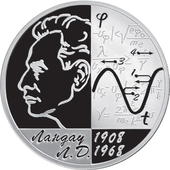
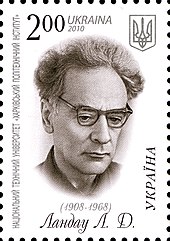
Two celestial objects are named in his honour:
- the minor planet 2142 Landau.[41]
- the lunar crater Landau.
The highest prize in theoretical physics awarded by the Russian Academy of Sciences is named in his honour:
On 22 January 2019, Google celebrated what would have been Landau's 111th birthday with a Google Doodle.[42]
The Landau-Spitzer Award (American Physical Society), which recognizes outstanding contributions to plasma physics and European-United States collaboration, is named in-part in his honor.[43]
Landau's ranking of physicists
Landau kept a list of names of physicists which he ranked on a logarithmic scale of productivity ranging from 0 to 5.[44][45] The highest ranking, 0, was assigned to Isaac Newton. Albert Einstein was ranked 0.5. A rank of 1 was awarded to the founding fathers of quantum mechanics, Niels Bohr, Werner Heisenberg, Satyendra Nath Bose, Paul Dirac and Erwin Schrödinger, and others, while members of rank of 5 were deemed "pathologists".[46] Landau ranked himself as a 2.5 but later promoted to a 2. N. David Mermin, writing about Landau, referred to the scale, and ranked himself in the fourth division, in the article "My Life with Landau: Homage of a 4.5 to a 2".[47][45][48]
In popular culture
- The Russian television film My Husband – the Genius (translation of the Russian title Мой муж – гений) released in 2008 tells the biography of Landau (played by Daniil Spivakovsky), mostly focusing on his private life. It was generally panned by critics. People who had personally met Landau, including famous Russian scientist Vitaly Ginzburg, said that the film was not only terrible but also false in historical facts.
- Another film about Landau, Dau, is directed by Ilya Khrzhanovsky with non-professional actor Teodor Currentzis (an orchestra conductor) as Landau. Dau was a common nickname of Lev Landau.[49] The film was part of the multidisciplinary art project DAU.[50][51]
Works
Landau wrote his first paper On the derivation of Klein–Fock equation, co-authored with Dmitri Ivanenko in 1926, when he was 18 years old. His last paper titled Fundamental problems appeared in 1960 in an edited version of tributes to Wolfgang Pauli. A complete list of Landau's works appeared in 1998 in the Russian journal Physics-Uspekhi.[52] Landau would allow himself to be listed as a co-author of a journal article on two conditions: 1) he brought up the idea of the work, partly or entirely, and 2) he performed at least some calculations presented in the article. Consequently, he removed his name from numerous publications of his students where his contribution was less significant.[49]
Course of Theoretical Physics
- L. D. Landau, E. M. Lifshitz (1976). Mechanics. Vol. 1 (3rd ed.). Butterworth–Heinemann. ISBN 978-0-7506-2896-9.
- L. D. Landau; E. M. Lifshitz (1975). The Classical Theory of Fields. Vol. 2 (4th ed.). Butterworth–Heinemann. ISBN 978-0-7506-2768-9.
- L. D. Landau; E. M. Lifshitz (1977). Quantum Mechanics: Non-Relativistic Theory. Vol. 3 (3rd ed.). Pergamon Press. ISBN 978-0-08-020940-1. — 2nd ed. (1965) at archive.org
- V. B. Berestetskii; E. M. Lifshitz; L. P. Pitaevskii (1982). Quantum Electrodynamics. Vol. 4 (2nd ed.). Butterworth–Heinemann. ISBN 978-0-7506-3371-0.
- L. D. Landau; E. M. Lifshitz (1980). Statistical Physics, Part 1. Vol. 5 (3rd ed.). Butterworth–Heinemann. ISBN 978-0-7506-3372-7.
- L. D. Landau; E. M. Lifshitz (1987). Fluid Mechanics. Vol. 6 (2nd ed.). Butterworth–Heinemann. ISBN 978-0-08-033933-7.
- L. D. Landau; E. M. Lifshitz (1986). Theory of Elasticity. Vol. 7 (3rd ed.). Butterworth–Heinemann. ISBN 978-0-7506-2633-0.
- L. D. Landau; E. M. Lifshitz; L. P. Pitaevskii (1984). Electrodynamics of Continuous Media. Vol. 8 (2nd ed.). Butterworth–Heinemann. ISBN 978-0-7506-2634-7.
- L. P. Pitaevskii; E. M. Lifshitz (1980). Statistical Physics, Part 2. Vol. 9 (1st ed.). Butterworth–Heinemann. ISBN 978-0-7506-2636-1.
- L. P. Pitaevskii; E. M. Lifshitz (1981). Physical Kinetics. Vol. 10 (1st ed.). Pergamon Press. ISBN 978-0-7506-2635-4.
Landau and Lifshitz suggested in the third volume of the Course of Theoretical Physics that the then-standard periodic table had a mistake in it, and that lutetium should be regarded as a d-block rather than an f-block element. Their suggestion was fully vindicated by later findings,[53][54][55][56] and in 1988 was endorsed by a report of the International Union of Pure and Applied Chemistry (IUPAC).[57]
Other
- L. D. Landau; A. S. Kompaneets (1965) [1935]. "Appendix A". The electrical conductivity of metals. ONTI, Kharkiv. pp. 803–832. doi:10.1016/B978-0-08-010586-4.50106-1. ISBN 9780080105864.
- L. D. Landau; Ya. Smorodinsky (2011) [1958]. Lectures on Nuclear Theory. Dover Publications. ISBN 978-0486675138.
- L. D. Landau; G. B. Rumer (2003) [1960]. What is Relativity?. Dover Publications. ISBN 978-0-48-616348-2.
- L. D. Landau; A. I. Akhiezer; E. M. Lifshitz (1967). General Physics, Mechanics and Molecular Physics. Pergamon Press. ISBN 978-0-08-009106-8.
- L. D. Landau; A. I. Kitaigorodsky (1978). Physics for Everyone. Mir Publishers Moscow. in 4 volumes: volume 1 Physical bodies ISBN 978-0-82-851716-4; volume 2 Molecules ISBN 978-0-82-851725-6; volume 3 Electrons and volume 4 Photons and nuclei; vols. 3 & 4 by Kitaigorodsky alone
See also
References
- ^ McCauley, Martin (1997). Who's Who in Russia Since 1900. Routledge. p. 128.
Landau, Lev Davydovich (1908-68), a brilliant Soviet theoretical physicist, who was born into a Jewish family in Baku and graduated from Leningrad State University in 1927.
- ^ Zubok, Vladislav (2012). "Soviet Intellectuals after Stalin's Death and Their Visions of the Cold War's End". In Bozo, Frédéric; Rey, Marie-Pierre; Rother, Bernd; Ludlow, N. Piers (eds.). Visions of the End of the Cold War in Europe, 1945-1990. Berghahn Books. p. 78.
- ^ a b c d e f g Gorelik, Gennady (August 1997). "The Top-Secret Life of Lev Landau". Scientific American. 277 (2): 72–77. Bibcode:1997SciAm.277b..72G. doi:10.1038/scientificamerican0897-72. JSTOR 24995874. Retrieved 18 June 2018.
- ^ Lev Landau (1927). "Das Dämpfungsproblem in der Wellenmechanik (The Damping Problem in Wave Mechanics)". Zeitschrift für Physik. 45 (5–6): 430–441. Bibcode:1927ZPhy...45..430L. doi:10.1007/bf01343064. S2CID 125732617. English translation reprinted in: D. Ter Haar, ed. (1965). Collected papers of L.D. Landau. Oxford: Pergamon Press.
- ^ Schlüter, Michael; Lu Jeu Sham (1982). "Density functional theory". Physics Today. 35 (2): 36. Bibcode:1982PhT....35b..36S. doi:10.1063/1.2914933. S2CID 126232754. Archived from the original on 15 April 2013.
- ^ Fisher, Michael E. (1 April 1998). "Renormalization group theory: Its basis and formulation in statistical physics". Reviews of Modern Physics. 70 (2): 653–681. Bibcode:1998RvMP...70..653F. doi:10.1103/RevModPhys.70.653.
- ^ Shifman, M., ed. (2013). Under the Spell of Landau: When Theoretical Physics was Shaping Destinies. World Scientific. doi:10.1142/8641. ISBN 978-981-4436-56-4.
- ^ a b Kapitza, P. L.; Lifshitz, E. M. (1969). "Lev Davydovitch Landau 1908–1968". Biographical Memoirs of Fellows of the Royal Society. 15: 140–158. doi:10.1098/rsbm.1969.0007.
- ^ Martin Gilbert, The Jews in the Twentieth Century: An Illustrated History, Schocken Books, 2001, ISBN 0805241906 p. 284
- ^ Frontiers of physics: proceedings of the Landau Memorial Conference, Tel Aviv, Israel, 6–10 June 1988, (Pergamon Press, 1990) ISBN 0080369391, pp. 13–14
- ^ Edward Teller, Memoirs: A Twentieth Century Journey In Science And Politics, Basic Books 2002, ISBN 0738207780 p. 124
- ^ "Great Baku native Lev Landau". Vestnik Kavkaza. Archived from the original on 10 June 2019. Retrieved 22 January 2019.
- ^ "Выпускники Могилевской гимназии". www.petergen.com. Retrieved 22 November 2022.
- ^ František Janouch, Lev Landau: A Portrait of a Theoretical Physicist, 1908–1988, Research Institute for Physics, 1988, p. 17.
- ^ Rumer, Yuriy. ЛАНДАУ. berkovich-zametki.com
- ^ a b c Bessarab, Maya (1971) Страницы жизни Ландау. Московский рабочий. Moscow
- ^ a b Mehra, Jagdish (2001) The Golden Age of Theoretical Physics, Boxed Set of 2 Volumes, World Scientific, p. 952. ISBN 9810243421.
- ^ During this period Landau visitied Copenhagen three times: 8 April to 3 May 1930, from 20 September to 22 November 1930, and from 25 February to 19 March 1931 (see Landau Lev biography – MacTutor History of Mathematics).
- ^ Sykes, J. B. (2013) Landau: The Physicist and the Man: Recollections of L. D. Landau, Elsevier, p. 81. ISBN 9781483286884.
- ^ Haensel, P.; Potekhin, A. Y. and Yakovlev, D. G. (2007) Neutron Stars 1: Equation of State and Structure, Springer Science & Business Media, p. 2. ISBN 0387335439.
- ^ Blundell, Stephen J. (2009). Superconductivity: A Very Short Introduction. Oxford U. Press. p. 67. ISBN 9780191579097.
- ^ Ioffe, Boris L. (25 April 2002). "Landau's Theoretical Minimum, Landau's Seminar, ITEP in the beginning of the 1950s". arXiv:hep-ph/0204295v1. Bibcode:2002hep.ph....4295I.
{{cite journal}}: Cite journal requires|journal=(help) - ^ On the Theory of Stars, in Collected Papers of L. D. Landau, ed. and with an introduction by D. ter Haar, New York: Gordon and Breach, 1965; originally published in Phys. Z. Sowjet. 1 (1932), 285.
- ^ Yakovlev, Dmitrii; Haensel, Pawel (2013). "Lev Landau and the concept of neutron stars". Physics-Uspekhi. 56 (3): 289–295. arXiv:1210.0682. Bibcode:2013PhyU...56..289Y. doi:10.3367/UFNe.0183.201303f.0307. S2CID 119282067.
- ^ a b Dorozynsk, Alexander (1965). The Man They Wouldn't Let Die.
- ^ Музей-кабинет Петра Леонидовича Капицы (Peter Kapitza Memorial Museum-Study), Академик Капица: Биографический очерк (a biographical sketch of Academician Kapitza).
- ^ O'Connor, 2014
- ^ Yakovlev, 2012
- ^ Richard Rhodes, Dark Sun: The Making of the Hydrogen Bomb, pub Simon & Schuster, 1995, ISBN 0684824140 p. 33.
- ^ "Lev Davidovich Landau, Soviet physicist and Nobel laureate". Physics Today. 57 (2): 62. 2004. Bibcode:2004PhT....57Q..62.. doi:10.1063/1.2408530.
- ^ Petr Leonidovich Kapitsa, Experiment, Theory, Practice: Articles and Addresses, Springer, 1980, ISBN 9027710619, p. 329.
- ^ Schaefer, Henry F. (2003). Science and Christianity: Conflict Or Coherence?. The Apollos Trust. p. 9. ISBN 9780974297507.
I present here two examples of notable atheists. The first is Lev Landau, the most brilliant Soviet physicist of the twentieth century.
- ^ "Lev Landau". Soylent Communications. 2012. Retrieved 7 May 2013.
- ^ James D. Patterson; Bernard C. Bailey (20 February 2019). Solid-State Physics: Introduction to the Theory. Lev Landau - The Soviet Grand Master: Springer. p. 190. ISBN 9783319753225.
Landau's theoretical minimum exam was famous and only about forty students passed it in his time. This was Landau's entry-level exam for theoretical physics. It contained what Landau felt was necessary to work in that field. Like many Soviet era physicists he was an atheist.
- ^ 19 December 1957* (no number). The Bukovsky Archives.
- ^ Nobel Presentation speech by Professor I. Waller, member of the Swedish Academy of Sciences. Nobelprize.org. Retrieved on 28 January 2012.
- ^ Kora Drobantseva's memoirs, Chapter 38, "The way we lived"; the episode with Alexander Luria (in the original Russian text, referred to as Лурье) testing Lev Landau on intellectual abilities
- ^ Yaacov Ro'i, The Struggle for Soviet Jewish Emigration, 1948–1967, Cambridge University Press 2003, ISBN 0521522447 p. 199
- ^ «Если нужен вор, его и с виселицы снимают»
- ^ Obelisk at the Novodevichye Cemetery. novodevichye.com (26 October 2008). Retrieved on 28 January 2012.
- ^ Schmadel, Lutz D. (2003). Dictionary of Minor Planet Names (5th ed.). Springer Verlag. p. 174. ISBN 3-540-00238-3.
- ^ Best, Shivali (22 January 2019). "Google Doodle celebrates 111th birthday of theoretical physicist Lev Landau". mirror. Retrieved 22 January 2019.
- ^ "Landau-Spitzer Award". APS.org. American Physical Society.
- ^ Li, Jichao; Yin, Yian; Fortunato, Santo; Wang, Dashun (18 April 2019). "Nobel laureates are almost the same as us". Nature Reviews Physics. 1 (5): 301–303. Bibcode:2019NatRP...1..301L. doi:10.1038/s42254-019-0057-z. Retrieved 9 April 2024.
- ^ a b Hey, Tony (1997). Einstein's Mirror. Cambridge University Press. p. 1. ISBN 0-521-43532-3.
- ^ Anna Livanova (1983). Ландау [Landau] (in Russian) (2nd expanded ed.). Znanie. Retrieved 1 August 2022.
- ^ N. David Mermin (1990). Boojums All the Way Through: Communicating Science in a Prosaic Age. Cambridge University Press. p. 39. ISBN 9780521388801.
- ^ Mitra, Asoke; Ramlo, Susan; Dharamsi, Amin; Mitra, Asoke; Dolan, Richard; Smolin, Lee (2006). "New Einsteins Need Positive Environment, Independent Spirit". Physics Today. 59 (11): 10. Bibcode:2006PhT....59k..10H. doi:10.1063/1.2435630.
- ^ a b Дао Ландау Archived 7 October 2015 at the Wayback Machine. strf.ru (25 January 2008)
- ^ Dau: a never-ending experiment in a Soviet laboratory
- ^ DAU: Strange, Repellent, Mesmerising, Addictive
- ^ "Complete list of L D Landau's works". Phys. Usp. 41 (6): 621–623. June 1998. Bibcode:1998PhyU...41..621.. doi:10.1070/PU1998v041n06ABEH000413.
- ^ Wittig, Jörg (1973). "The pressure variable in solid state physics: What about 4f-band superconductors?". In H. J. Queisser (ed.). Festkörper Probleme: Plenary Lectures of the Divisions Semiconductor Physics, Surface Physics, Low Temperature Physics, High Polymers, Thermodynamics and Statistical Mechanics, of the German Physical Society, Münster, March 19–24, 1973. Advances in Solid State Physics. Vol. 13. Berlin, Heidelberg: Springer. pp. 375–396. doi:10.1007/BFb0108579. ISBN 978-3-528-08019-8.
- ^ Matthias, B. T. (1969). "Systematics of Super Conductivity". In Wallace, P. R. (ed.). Superconductivity. Vol. 1. Gordon and Breach. pp. 225–294. ISBN 9780677138107.
- ^ William B. Jensen (1982). "The Positions of Lanthanum (Actinium) and Lutetium (Lawrencium) in the Periodic Table". J. Chem. Educ. 59 (8): 634–636. Bibcode:1982JChEd..59..634J. doi:10.1021/ed059p634.
- ^ Scerri, Eric R (2020). The Periodic Table, Its Story and Its Significance, 2nd edition, Oxford University Press, New York, ISBN 978-0190914363
- ^ Fluck, E. (1988). "New Notations in the Periodic Table" (PDF). Pure Appl. Chem. 60 (3): 431–436. doi:10.1351/pac198860030431. S2CID 96704008. Archived (PDF) from the original on 25 March 2012. Retrieved 24 March 2012.
Further reading
- Books
- Dorozynski, Alexander (1965). The Man They Wouldn't Let Die. Secker and Warburg. ASIN B0006DC8BA. (After Landau's 1962 car accident, the physics community around him rallied to attempt to save his life. They managed to prolong his life until 1968.)
- Janouch, Frantisek (1979). Lev D. Landau: His life and work. CERN. ASIN B0007AUCL0.
- Khalatnikov, I. M., ed. (1989). Landau. The physicist and the man. Recollections of L. D. Landau. Sykes, J. B. (trans.). Pergamon Press. ISBN 0-08-036383-0.
- Kojevnikov, Alexei B. (2004). Stalin's Great Science: The Times and Adventures of Soviet Physicists. History of Modern Physical Sciences. Imperial College Press. ISBN 1-86094-420-5.
- Landau-Drobantseva, Kora (1999). Professor Landau: How We Lived (in Russian). AST. ISBN 5-8159-0019-2. Archived from the original on 4 May 2005.
- Shifman, M., ed. (2013). Under the Spell of Landau: When Theoretical Physics was Shaping Destinies. World Scientific. doi:10.1142/8641. ISBN 978-981-4436-56-4.
- Articles
- Karl Hufbauer, "Landau's youthful sallies into stellar theory: Their origins, claims, and receptions", Historical Studies in the Physical and Biological Sciences, 37 (2007), 337–354.
- "As a student, Landau dared to correct Einstein in a lecture". Global Talent News.
- O'Connor, John J.; Robertson, Edmund F., "Lev Landau", MacTutor History of Mathematics Archive, University of St Andrews
- Lev Davidovich Landau. Nobel-Winners.
- Landau's Theoretical Minimum, Landau's Seminar, ITEP in the Beginning of the 1950s by Boris L. Ioffe, Concluding talk at the workshop QCD at the Threshold of the Fourth Decade/Ioeffest.
- EJTP Landau Issue 2008.
- Ammar Sakaji and Ignazio Licata (eds), Lev Davidovich Landau and his Impact on Contemporary Theoretical Physics, Nova Science Publishers, New York, 2009, ISBN 978-1-60692-908-7.
- Gennady Gorelik, "The Top Secret Life of Lev Landau", Scientific American, Aug. 1997, vol. 277(2), 53–57, JSTOR link.
- Maya Bessarab, "Landau's Life Pages(in Russian)".
External links
 Media related to Lev Landau at Wikimedia Commons
Media related to Lev Landau at Wikimedia Commons Quotations related to Lev Landau at Wikiquote
Quotations related to Lev Landau at Wikiquote- Lev Landau on Nobelprize.org
- Lev Landau
- 1908 births
- 1968 deaths
- Soviet Nobel laureates
- Azerbaijani Jews
- Scientists from Baku
- Burials at Novodevichy Cemetery
- Fluid dynamicists
- Foreign associates of the National Academy of Sciences
- Foreign Members of the Royal Society
- Full Members of the USSR Academy of Sciences
- Nobel laureates in Physics
- Heroes of Socialist Labour
- Recipients of the Stalin Prize
- Recipients of the Lenin Prize
- Recipients of the Order of the Badge of Honour
- Recipients of the Order of Lenin
- Recipients of the Order of the Red Banner of Labour
- Winners of the Max Planck Medal
- Jewish atheists
- Jewish physicists
- Members of the German National Academy of Sciences Leopoldina
- Academic staff of Moscow State University
- Academic staff of the Moscow Institute of Physics and Technology
- People from Baku Governorate
- Saint Petersburg State University alumni
- Soviet atheists
- Soviet inventors
- Soviet Jews
- Soviet physicists
- Theoretical physicists
- Academic staff of the National University of Kharkiv
- Superfluidity
- People involved with the periodic table
- Russian scientists

